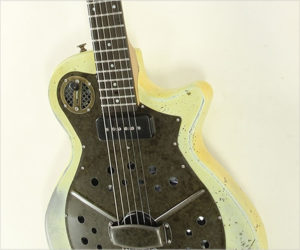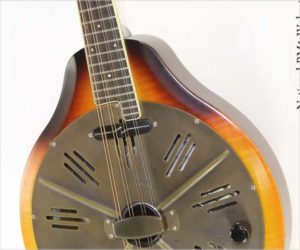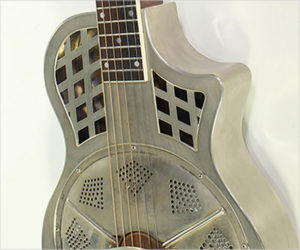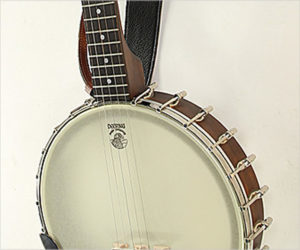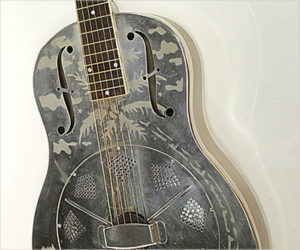Here we have a National Resophonic T-14 Cutaway Tricone in a Weathered Steel finish. The official model number is ‘T-14WS’, and it’s a slim, steel bodied, three cone resophonic guitar with a 14-fret neck. And at under eight pounds, it weighs less than many solid body electrics! The T-14 Cutaway Tricone is full-scale guitar, at 25.66 inches. This requires a bit more tension on the strings and the cones, which can result in increased volume.
Resonator
We’ve received a brand-new National Reso-Phonic Pioneer RP1 semi-hollow electric in a fabulous Chipped Ivory finish! These are great guitars with unmistakable tone and the solid build quality expected from a National Reso-Phonic guitar. The neck is maple with ebony fingerboard, and the body is semi-hollow finished steel. The Lollar P-90 in the neck position provides a warm, fat tone and the piezo element in the bridge accurately reproduces the resonator tone. Active circuity rounds it out.
This instrument has sold
MORE →The National RM1 Walnut is built in San Luis Opisbo California and features a teardrop, almost ‘A Style’ body shape, but with a single 9.5 inch resonator cone. The RM1 Walnut pairs a figured Maple top with Black Walnut for the sides and carved back; the neck is figured Maple with a bound Ebony fingerboard. Because it’s a reso-phonic instrument, the bridge is built into the center of the resonator cone.
This instrument has sold
MORE →The Republic Highway 61 has a single cone resonator, 12 inch wide body – around the size of a Les Paul, and has a 25 inch scale length with 1 13/16 inch nut width. The body sports lattice soundholes like those on a Tricone model, so there’s lots of space for air to move. These sound good, and the smaller size makes them a lot of fun, and easy to play.
This instrument has sold
MORE →Today we’re looking at one of the seminal resophonic guitars, a National Style 0 in ‘Etched Silver’ finish dating to around 1930. The Resophonic design dates to 1927 as a successful effort in increasing volume. While tri-cone models were the first, the single cone Style 0 offered more volume and lower production costs, though the harmonic content is not as rich as the tri-cone. In general, single cone models provide a sharp attack and quick decay, somewhat like a banjo, while tri-cones deliver a smoother rise and more sustain.
This instrument has sold
MORE →